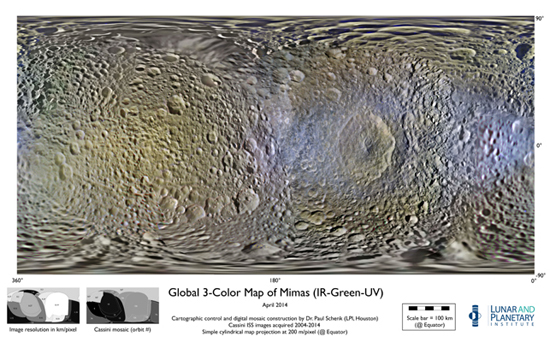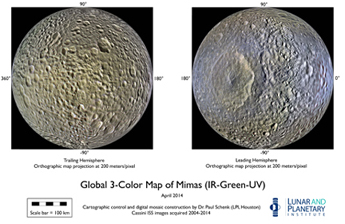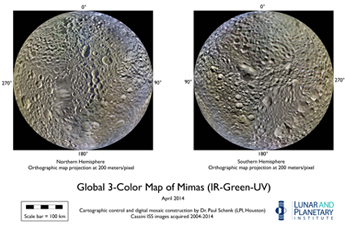Color Maps of Mimas - 2014
 |
Download the High Resolution JPEG
  | |
Download the High Resolution JPEG
Download the High Resolution JPEG
This set of global, color mosaics of Saturn's moon Mimas was produced from images taken by NASA's Cassini spacecraft during its first ten years exploring the Saturn system. These are the first global color maps of these moons produced from the Cassini data.
The colors shown in these global mosaics are enhanced, or broader, relative to human vision, extending into the ultraviolet and infrared range.
Apart from the moon's enormous impact crater, named Herschel, a dramatic feature on these maps is the equatorial band on Mimas' leading hemisphere. Cassini found this band to be significantly brighter in the ultraviolet than surrounding terrains, and it appears somewhat bluish here. This feature, similar to one on Tethys, was found to correlate with the predicted pattern of bombardment of the moons' surfaces by high-energy electrons trapped in Saturn's magnetic field. This bombardment is thought to alter the surface ices on a crystalline scale and change their color. Later thermal observations by Cassini's Composite Infrared Spectrometer (CIRS) instrument showed that these features also form thermal anomalies on the surface, giving rise to the nickname "Pac-Man" features (see PIA16198).
Resolution on Mimas in the maps is 200 meters per pixel.
Image selection, radiometric calibration, geographic registration and photometric correction, as well as mosaic selection and assembly were performed by Paul Schenk at the Lunar and Planetary Institute. Original image planning and targeting for Saturn's icy moons were performed by Tilman Denk (Frei Universitat, Berlin) and Paul Helfenstein (Cornell University, Ithaca, New York).
The Cassini-Huygens mission is a cooperative project of NASA, the European Space Agency and the Italian Space Agency. NASA's Jet Propulsion Laboratory, a division of the California Institute of Technology in Pasadena, manages the mission for NASA's Science Mission Directorate, Washington. The Cassini orbiter and its two onboard cameras were designed, developed and assembled at JPL. The imaging operations center is based at the Space Science Institute in Boulder, Colo.
For more information about the Cassini-Huygens mission visit http://saturn.jpl.nasa.gov and http://www.nasa.gov/cassini. The Cassini imaging team homepage is at http://ciclops.org.
